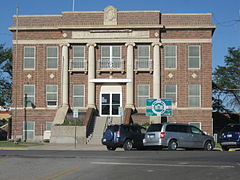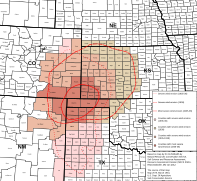Boise City, Oklahoma
Boise City, Oklahoma | |
|---|---|
City | |
 Cimarron County Courthouse (2009) | |
 Location within Cimarron County and Oklahoma | |
| Coordinates: 36°43′48″N 102°30′41″W / 36.73000°N 102.51139°W / 36.73000; -102.51139Coordinates: 36°43′48″N 102°30′41″W / 36.73000°N 102.51139°W / 36.73000; -102.51139 | |
| Country | United States |
| State | Oklahoma |
| County | Cimarron |
| Area | |
| • Total | 1.3 sq mi (3.3 km2) |
| • Land | 1.3 sq mi (3.3 km2) |
| • Water | 0.0 sq mi (0.0 km2) |
| Elevation | 4,167 ft (1,270 m) |
| Population (2010) | |
| • Total | 1,266 |
| • Estimate (2013)[1] | 1,189 |
| • Density | 970/sq mi (380/km2) |
| Time zone | UTC-6 (Central (CST)) |
| • Summer (DST) | UTC-5 (CDT) |
| ZIP code | 73933 |
| Area code(s) | 580 |
| FIPS code | 40-07300 [2] |
GNIS feature ID | 1090365 [3] |
Boise City /ˈbɔɪs/ is a city in and the county seat of Cimarron County, Oklahoma, United States.[4] The population was 1,266 at the 2010 census, a decline of 14.6 percent from 1,483 in 2000.[5] According to the Encyclopedia of Oklahoma History and Culture, the origin of the town name is unclear.[6]
Contents
1 History
2 Geography
2.1 Climate
3 Demographics
4 Economy
5 Notable people
6 Gallery
7 See also
8 Notes
9 References
10 Further reading
11 External links
History
Boise City was founded in 1908 by developers J. E. Stanley, A. J. Kline, and W. T. Douglas (all doing business as the Southwestern Immigration and Development Company of Guthrie, Oklahoma) and who published and distributed brochures promoting the town as an elegant, tree-lined city with paved streets, numerous businesses, railroad service, and an artesian well.[a] They sold 3,000 lots to buyers who discovered, on their arrival, that none of the information in the brochure was true. In addition to using false publicity, the three men did not have title to the lots they sold. Stanley and Kline were convicted of mail fraud and sent to Leavenworth Federal Penitentiary. Stanley and Kline served two-year terms in the penitentiary. Douglas died of tuberculosis before beginning his sentence. The town nevertheless took shape and incorporated on July 20, 1925.[6]
The Encyclopedia of Oklahoma History and Culture says that the origin of the town name is unclear, but offers three possibilities: (1) a Captain Boice who was a hero in the Civil War, (2) the town of Boise, Idaho or (3) the Boise Cattle Company, which ran cattle in the area.[6] It was speculated in Ken Burns' documentary, The Dust Bowl (film), that the town name was chosen as part of the original land scam to infer a false image of the town, as "boisé" is French for "wooded".
Boise City's prosperity in the 1930s, like that of Cimarron County generally, was severely affected by its location at the heart of the Dust Bowl region.[7][8]
Boise City was the location of an unusual event during World War II when it was mistakenly bombed by a friendly U.S. bomber crew during training. The bombing occurred on July 5, 1943, at approximately 12:30 a.m. by a B‑17 Flying Fortress Bomber.[9] This occurred because pilots performing target practice became disoriented and mistook the lights around the town square as their target. No one was killed in the attack (only practice bombs were used and the square was deserted at the time), but the pilots were embarrassed. For the 50th anniversary of the incident, the crew of the bomber was invited back to Boise City, but all members declined. The former radio operator did, however, send an audio tape that was played at the celebration.[10]
Geography
Boise City is located at 36°43′48″N 102°30′41″W / 36.73000°N 102.51139°W / 36.73000; -102.51139 (36.730115, -102.511419).[11] According to the United States Census Bureau, the city has a total area of 1.3 square miles (3.4 km2), all land.
The Boise City Airport, which serves all of the county, is located approximately four miles north of Boise City.
Climate
Boise City experiences a semi-arid climate (Köppen BSk) with mild, dry winters and long, hot, wetter summers. There is a large degree of diurnal temperature variation year-round.
According to weather data tallied between July 1, 1985 and June 30, 2015 for every location in the National Oceanic and Atmospheric Administration's official climate database, Boise City, Oklahoma, is the snowiest place in the state of Oklahoma with an average of 30.8 inches of snow per year.
[12]
| Climate data for Boise City, OK (Data for 1908–2012) | |||||||||||||
|---|---|---|---|---|---|---|---|---|---|---|---|---|---|
| Month | Jan | Feb | Mar | Apr | May | Jun | Jul | Aug | Sep | Oct | Nov | Dec | Year |
| Record high °F (°C) | 80 (27) | 85 (29) | 91 (33) | 97 (36) | 108 (42) | 108 (42) | 107 (42) | 105 (41) | 105 (41) | 96 (36) | 87 (31) | 84 (29) | 108 (42) |
| Average high °F (°C) | 48.9 (9.4) | 52.9 (11.6) | 60.6 (15.9) | 70.0 (21.1) | 78.3 (25.7) | 88.3 (31.3) | 92.8 (33.8) | 90.5 (32.5) | 83.1 (28.4) | 72.3 (22.4) | 59.4 (15.2) | 49.5 (9.7) | 70.5 (21.4) |
| Average low °F (°C) | 19.3 (−7.1) | 22.5 (−5.3) | 28.5 (−1.9) | 38.0 (3.3) | 47.4 (8.6) | 57.4 (14.1) | 62.5 (16.9) | 61.0 (16.1) | 52.9 (11.6) | 40.7 (4.8) | 28.6 (−1.9) | 21.1 (−6.1) | 40.0 (4.4) |
| Record low °F (°C) | −24 (−31) | −16 (−27) | −12 (−24) | 6 (−14) | 20 (−7) | 31 (−1) | 39 (4) | 36 (2) | 25 (−4) | 9 (−13) | −7 (−22) | −17 (−27) | −24 (−31) |
| Average precipitation inches (mm) | 0.43 (11) | 0.45 (11) | 0.96 (24) | 1.29 (33) | 2.39 (61) | 2.44 (62) | 2.50 (64) | 2.67 (68) | 1.61 (41) | 1.32 (34) | 0.71 (18) | 0.56 (14) | 17.33 (440) |
| Average snowfall inches (cm) | 4.8 (12) | 3.8 (9.7) | 5.4 (14) | 1.6 (4.1) | 0.3 (0.76) | 0 (0) | 0 (0) | 0 (0) | 0.1 (0.25) | 0.9 (2.3) | 3.0 (7.6) | 5.4 (14) | 25.5 (65) |
| Average precipitation days (≥ 0.01 in) | 3.1 | 3.4 | 4.9 | 4.7 | 7.0 | 7.0 | 7.1 | 6.3 | 4.6 | 3.4 | 3.2 | 2.8 | 57.5 |
| Source: The Western Regional Climate Center[13] | |||||||||||||
Demographics
| Historical population | |||
|---|---|---|---|
| Census | Pop. | %± | |
| 1930 | 1,256 | — | |
| 1940 | 1,144 | −8.9% | |
| 1950 | 1,902 | 66.3% | |
| 1960 | 1,978 | 4.0% | |
| 1970 | 1,993 | 0.8% | |
| 1980 | 1,761 | −11.6% | |
| 1990 | 1,509 | −14.3% | |
| 2000 | 1,483 | −1.7% | |
| 2010 | 1,266 | −14.6% | |
| Est. 2015 | 1,127 | [14] | −11.0% |
| U.S. Decennial Census | |||
As of the census[2] of 2000, there were 1,483 people, 610 households, and 400 families residing in the city. The population density was 1,180.6 people per square mile (454.4/km²). There were 752 housing units at an average density of 598.7 per square mile (230.4/km²). The racial makeup of the city was 81.7% White, 0.2% African American, 1.7% Native American, 0.3% Asian, 13.4% from other races, and 2.8% from two or more races. Hispanic or Latino of any race were 21.0% of the population.
There were 610 households out of which 29.8% had children under the age of 18 living with them, 55.1% were married couples living together, 7.5% had a female householder with no husband present, and 34.3% were non-families. 33.1% of all households were made up of individuals and 18.4% had someone living alone who was 65 years of age or older. The average household size was 2.36 and the average family size was 2.99.
In the city, the population was spread out with 26.2% under the age of 18, 6.6% from 18 to 24, 21.7% from 25 to 44, 24.3% from 45 to 64, and 21.2% who were 65 years of age or older. The median age was 41 years. For every 100 females, there were 90.4 males. For every 100 females age 18 and over, there were 87.5 males.
The median income for a household in the city was $30,071, and the median income for a family was $35,761. Males had a median income of $23,088 versus $17,679 for females. The per capita income for the city was $15,821. About 14.7% of families and 19.1% of the population were below the poverty line, including 24.0% of those under age 18 and 12.3% of those age 65 or over.
Economy
The local economy is based on ranching, farming, and the production of oil and natural gas.[6]
Notable people
- Actress Vera Miles[15]
Gallery
Boise City in March, 2009.
The main highway through Boise City, looking west.

Cimarron County Courthouse, September 2011.

Area affected by the Dust Bowl between 1935 and 1938
See also
- LORAN-C transmitter Boise
- National Register of Historic Places listings in Cimarron County, Oklahoma
Notes
^ They had claimed that three railroads were coming through the town. In fact, only the Atchison, Topeka & Santa Fe Railroad ever came through Boise City, and that was not until 1925.[6]
References
^ "Population Estimates". United States Census Bureau. Retrieved 2015-03-07..mw-parser-output cite.citation{font-style:inherit}.mw-parser-output .citation q{quotes:"""""""'""'"}.mw-parser-output .citation .cs1-lock-free a{background:url("//upload.wikimedia.org/wikipedia/commons/thumb/6/65/Lock-green.svg/9px-Lock-green.svg.png")no-repeat;background-position:right .1em center}.mw-parser-output .citation .cs1-lock-limited a,.mw-parser-output .citation .cs1-lock-registration a{background:url("//upload.wikimedia.org/wikipedia/commons/thumb/d/d6/Lock-gray-alt-2.svg/9px-Lock-gray-alt-2.svg.png")no-repeat;background-position:right .1em center}.mw-parser-output .citation .cs1-lock-subscription a{background:url("//upload.wikimedia.org/wikipedia/commons/thumb/a/aa/Lock-red-alt-2.svg/9px-Lock-red-alt-2.svg.png")no-repeat;background-position:right .1em center}.mw-parser-output .cs1-subscription,.mw-parser-output .cs1-registration{color:#555}.mw-parser-output .cs1-subscription span,.mw-parser-output .cs1-registration span{border-bottom:1px dotted;cursor:help}.mw-parser-output .cs1-ws-icon a{background:url("//upload.wikimedia.org/wikipedia/commons/thumb/4/4c/Wikisource-logo.svg/12px-Wikisource-logo.svg.png")no-repeat;background-position:right .1em center}.mw-parser-output code.cs1-code{color:inherit;background:inherit;border:inherit;padding:inherit}.mw-parser-output .cs1-hidden-error{display:none;font-size:100%}.mw-parser-output .cs1-visible-error{font-size:100%}.mw-parser-output .cs1-maint{display:none;color:#33aa33;margin-left:0.3em}.mw-parser-output .cs1-subscription,.mw-parser-output .cs1-registration,.mw-parser-output .cs1-format{font-size:95%}.mw-parser-output .cs1-kern-left,.mw-parser-output .cs1-kern-wl-left{padding-left:0.2em}.mw-parser-output .cs1-kern-right,.mw-parser-output .cs1-kern-wl-right{padding-right:0.2em}
^ ab "American FactFinder". United States Census Bureau. Archived from the original on 2013-09-11. Retrieved 2008-01-31.
^ "US Board on Geographic Names". United States Geological Survey. 2007-10-25. Retrieved 2008-01-31.
^ "Find a County". National Association of Counties. Archived from the original on 2011-05-31. Retrieved 2011-06-07.
^ CensusViewer:Boise City, Oklahoma Population. Retrieved December 4, 2013.
^ abcde Young, Norma Gene. "Boise City," Encyclopedia of Oklahoma History and Culture. Accessed June 17, 2015.
^ Seelye, Katharine Q. "Survivor of Dust Bowl Now Battles a Fiercer Drought." New York Times. May 3, 2011. Accessed July 23, 2017.
^ Parker, Laura. "Parched: A New Dust Bowl Forms in the Heartland." National Geographic." May 17, 2014. Accessed July 23, 2017.
^ "War: The Bombing of Boise City". Time. July 19, 1943.
^ Dary, David (10 March 2015). "Bombed-Out Boise City". This Land Press. Retrieved 11 March 2015.
^ "US Gazetteer files: 2010, 2000, and 1990". United States Census Bureau. 2011-02-12. Retrieved 2011-04-23.
^ "The Snowiest Place in Each State". Retrieved 2015-01-24.
^ "Seasonal Temperature and Precipitation Information". Western Regional Climate Center. Retrieved April 4, 2013.
^ "Annual Estimates of the Resident Population for Incorporated Places: April 1, 2010 to July 1, 2015". Archived from the original on June 2, 2016. Retrieved July 2, 2016.
^ Foley, Jr., Hugh W. "Vera Miles," Encyclopedia of Oklahoma History and Culture, Oklahoma Historical Society; accessed May 5, 2015.
Further reading
Egan, Timothy (2006). The worst hard time : the untold story of those who survived the great American dust bowl. Boston: Mariner Books. ISBN 0-618-34697-X. OCLC 58788898.
External links
| Wikimedia Commons has media related to Boise City, Oklahoma. |
- Boise City Public Schools
The Boise City News, local newspaper- Encyclopedia of Oklahoma History and Culture - Boise City




